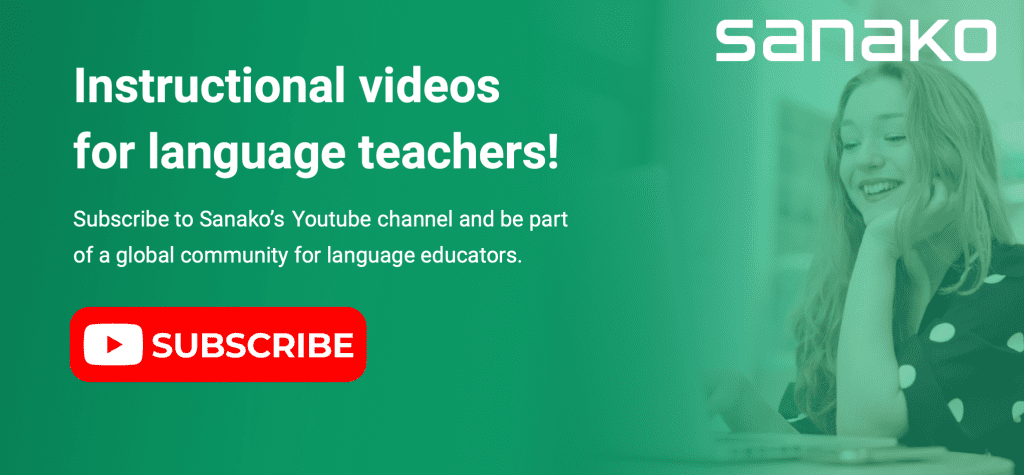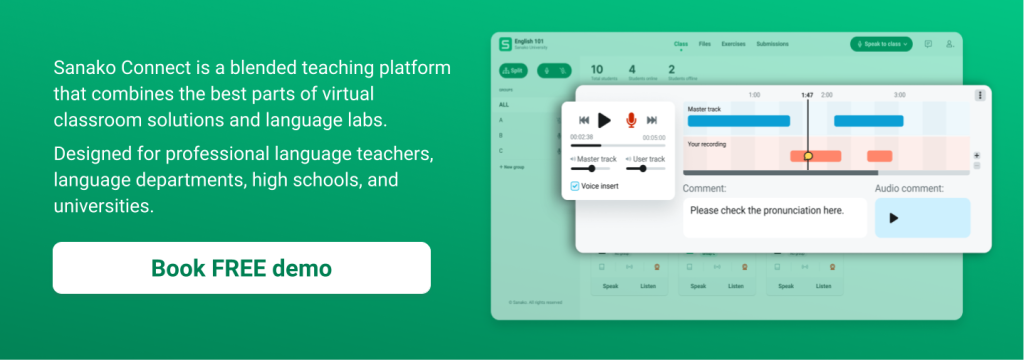Stories are an old but always current tool for conveying meaning and fixing ideas in our memory. Using stories within the language classroom can turn language learning into a smooth and stimulating process. The Teaching Proficiency Through Reading and Storytelling (TPRS) is an effective way to build a language lesson around a story while keeping students’ engagement and attention high.
Why incorporate stories into foreign language teaching?
Learning a new language takes time and cannot be done without memorization exercises. Students repeating new vocabulary or grammar rules in front of their workbooks are still a familiar sight in many language classes. However, is it an efficient and motivational learning approach?
In a previous article, we analyzed why the traditional methods of language teaching, based mainly on rote learning, have limited effectiveness. While memorization is an integral part of studying a new language, there are teaching methods that frame this process within interactive and dynamic contexts, where students are asked to create meaning, not simply to assimilate it in a passive way.
Crafting stories with students is an effective way to stimulate learners’ memory actively. Stories may appear as simple, childish even, but they interact powerfully with our cognitive abilities. As Joe Lazauskas and Shane Snow pointedly argued in The Storytelling Edge:
“Good stories surprise us. They make us think and feel. They stick in our minds and help us remember ideas and concepts in a way that a PowerPoint … never can”.
If you want your students to reach fluency naturally and engagingly, the Teaching Proficiency Through Reading and Storytelling (TPRS) might be the solution you were looking for.
The background of the TPRS Approach
The author of TPRS was Spanish teacher Blaine Ray. In the 1980s Ray developed an original study method based on concepts derived from previous language acquisition strategies.
The authors who most influenced Ray’s work were Dr. Stephen Krashen and Dr. James Asher, respectively authors of the Input Hypothesis and the Total Physical Response method.
Stephen Krashen developed a theory that attributed a crucial role in language acquisition to the so-called Comprehensible Inputs (CI).
According to Krashen, CIs, i.e. language input of which we can grasp the general meaning, are the basis of language acquisition. Krashen uses the expression language acquisition to distinguish it from language learning. The process of acquisition is natural and results from interaction with the environment. On the contrary, the learning process occurs within a structured context, such as the traditional classroom activities, and is based mainly on the assimilation of language rules and notions.
On the other hand, Dr. Asher’s Total Physical Response method is based on the principle that there is an interaction between physical movement and the process of language learning. The formulation of the Total Physical Response model took into account observation of how children learn to speak their mother tongue, i.e., using physical movements in response to verbal input.
What elements of the Input Hypothesis and Total Physical Response method went into Ray Blaine’s storytelling based teaching strategy? On the one hand, language instruction should leverage Comprehensible Inputs to train the learner to acquire language naturally. On the other hand, it also includes the principle that language acquisition should be supported by actions and interactions between students and teachers.
The role of stories in language teaching
But where does the storytelling come into place?
As the popular saying goes: “people don’t remember facts and figures, they remember the stories“. The truthfulness of this affirmation has been confirmed by studies that have induced to exploit the potentialities of the storytelling inside of business and institutional contexts.
To put it simply, in the TPRS method, stories are used as a tool to convey comprehensible input – needed to guide students to learn new vocabulary – within a setting that requires continuous communication between learners and teacher. All subjects in the classroom play a role in weaving the plot of the story. There is no passive repetition but rather a continuous creative effort – a crucial element in maintaining high student participation.
In this language teaching methodology, “acquisition of the target language is anchored in stories that students hear, read, write, tell, and retell in class with the guidance of the teacher. There is a tremendous focus on first comprehending a story and building confidence with it before actually writing or telling it, the approach puts input at the core of the curriculum”.
The strength of the TPRS approach is that it leverages the persuasive and suggestive power of storytelling to systematically expose students to foreign languages within a stimulating and interactive context.
As we will see in the next paragraph, stories provide language teachers with a tool to channel students’ efforts towards the repetition of verbs, nouns, adjectives.
A typical TPRS lesson begins with the teacher choosing a set of target words and explaining their meaning to the class. During the course of the lesson, students will be led to repeat the target words constantly.
The act of memorization, however, is closely linked to the unfolding of the narrative. Students repeat the words as the teacher animates the story. All participants can be involved in the story’s development: who are the characters, what will happen next, what will be the ending. Students may also be asked to act out parts of the story.
In this way, students assimilate new vocabulary through a process that has been called “non-repetitive repetition” — that is, a way of repeating and memorizing vocabulary anchored to concrete and meaningful situations.
If you are a language teacher interested in exploring new teaching methods and tools to make teaching more effective and efficient, then do check out Sanako’s Youtube Channel and our instructional videos for language educators! Subscribe now and be part of a global community for language educators!
A TPRS language classroom in practice
Just like any good story, a TPRS lesson has several parts. However, we have isolated the three most important:
Part one – Choosing the target words: From an instructional perspective, target words are the stars of the story. These are the words that students will need to learn throughout the lesson. The most effective approach is to choose a maximum of three words so that students’ concentration is not wasted. Then, the teacher lists and explains the meaning of the target words.
Students need to get acquainted with the selected words. Therefore, give them time to understand the target words’ meaning and learn their pronunciation.
Moreover, it is important to recall the influence of the Total Physical Response method on the formulation of the TPRS. In a TPRS setting, physical activity can support students in their language acquisition journey. Therefore, many teachers encourage students to associate gestures with target words. Gesturing is an effective way to anchor the meaning of the target words into the learner’s mind.
Before moving on to the second step, it is essential to make sure that students have understood the meaning of the words presented to them. Therefore, the TPRS also includes a series of comprehension checks, known as Personalized Questions and Answers.
Part two – Build a story around the target words: This is where the actual storytelling comes in. The story develops around target words. It doesn’t have to be particularly complex, it just has to convey the meaning of the selected words and get students to repeat them as much as possible.
However, it is important to use the story as an element of entertainment to keep students focused. It is good practice, then, to invite students to develop the plot of the story. The personalization of the story by the students is an aspect that according to the TPRS methods needs to be properly emphasized.
But specifically, how do students assimilate target words? This is done through a technique called “parking”. Through parking, the teacher suspends the narrative to ask students some questions. The questions should prompt students to respond using the new words.
Part three – Reading Comprehension: The last stage provides students with additional support to practice using and acquiring new words. Reading exercises can be of various types and can be done either in class, as a follow-up to the exercise just done in the classroom, or assigned as homework.
In the Reading Comprehension phase, the teacher submits a story for students to translate. In this context, the teacher needs to ascertain that the students understand the meaning of each paragraph. Thus, during the reading phase, the focus shifts to understanding the text and acquiring the rules of grammar. However, as the TPRS methodology points out, the reading translation “is also implemented to explain the grammar so that grammar is tied to meaning, not tied to a grammar rule”.
The strength of the TPRS method is that it helps students expand their vocabulary in a creative and fun way and prompts them to use the target words in a natural conversational context immediately.
How to use new language teaching strategies in your language classroom?
At Sanako, developing language teaching and learning products that help teachers to create an engaging and efficient language learning environment is the mission we pursue.
Sanako’s language teaching software seeks to provide teachers and students with a flexible and interactive digital environment to experiment with the learning approaches they deem most appropriate.
We believe that the best method of learning a language is the one that works for you and your students! Through our language teaching software, you can experiment with different learning methodologies, from Communicative Language Teaching to Task-based or Project-based Language Learning.
Sanako offers the opportunity to try different learning methods because we understand that not everyone learns the same way. However, our goal is to encourage students to actively practice the language, whether through conversations with peers, interacting with the teacher, or studying a subject in a foreign language.
If you are interested to learn how Sanako Connect language teaching software can help you to deliver language lessons in the classroom & remotely, contact us now to book a free product demo!



